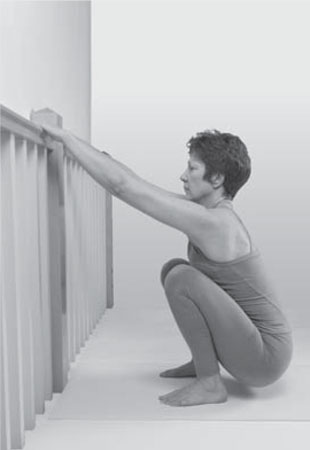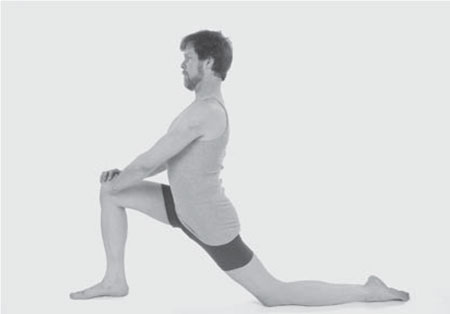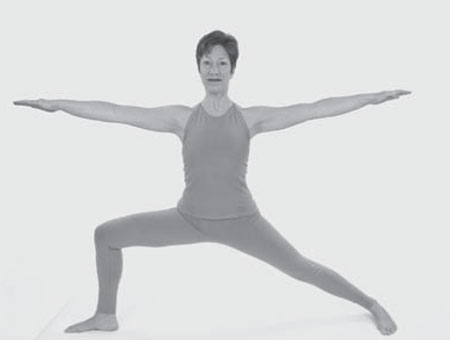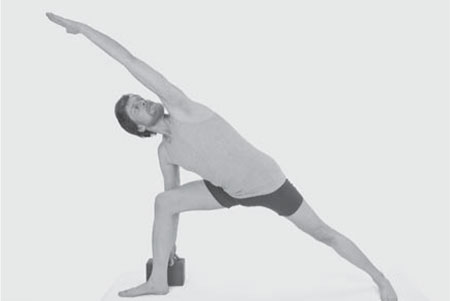Yoga for a Healthy Lower Back (11 page)
Read Yoga for a Healthy Lower Back Online
Authors: Liz Owen

FIG. 2.8
In this pose, space comes into the back of your hips and lower back as a result of the spinal traction you have created. Stay in the pose as long as you are comfortable. Come out by putting your hands behind you and sitting down onto the floor, or if your knees are healthy, you can fold your torso forward and slowly straighten your legs. Then roll your spine back up to Equal Balance Pose, one vertebra at a time, with your hands on your thighs to give support to your sacrum.
TIPS FOR A COMFORTABLE DEEP HIP BEND
Try one of these modifications if you experience discomfort in Deep Hip Bend.
â¢Â  Stand facing a short wall that's about waist high. Your kitchen counter works quite well for thisâstand in front of your sink and hook your hands onto the edge. Holding onto your support, walk your feet back two to three feet. Press your hips away from the support, taking your hips slightly back from your feet, and bring your arms and spine parallel to the floor. Look forward. Then slowly bend your knees until your thighs are at a right angle to your shins. Bring your ribs to your thighs. Pull your hips back, then drop them into a squat (
fig. 2.9
). The more you draw your hips away from the support and down, the more traction you will create for your sacral joints and lumbar spine. To come out of your pose, retrace your steps, slowly straightening your legs while still holding on to your support. Then walk toward it and come out of the pose.
â¢Â  Here's a playful modification: you and a friend can try to come into Deep Hip Bend together. Stand facing your friend. Hold each other's forearms and walk about three feet apart. At the same time, press your hips backward as far as possible away from each other, and start folding at your hip joints into a forward bend. Your hips should be farther away from your partner than your feet. Your arms should feel a stretch and your arms and spine should be parallel to the floor. Look at each other, slowly bend your knees, and take your hips down toward the floor, coming into Deep Hip Bend. Remember to hold your partner's forearms for support! Stay in this pose for as long as you both are comfortable. Then slowly straighten your legs up, lift your hips, walk toward each other, and come out of the pose.

FIG. 2.9
Low Lunge Pose
Stretch | Anjaneyasana Variation
Start on your hands and knees. Bring your right foot forward and place it in between your hands. Press both feet strongly down into the earth so you can lift your hands and place them on your hips. Feel your hips facing squarely forward. This is a good time to reestablish the neutral hip position I described in
Chair-Seated Hip Opener
. Feel your spine lifting vertically upward from your neutral hip position.
Now place your hands on your right thigh just above your knee, creating support for your upper spine by the triangular formation of your right thigh, torso, and arms. Scoop your tailbone forward and lift up from the center of the pelvic floor into your hips. Be very aware of what your lower abdomen and lower back are doing in this or any lunge. Your lower abdomen should draw in toward your spine and up toward your chest, and you should feel that your abdominal wall becomes engaged so it helps support your spine. Scoop your tailbone forward again to lengthen your lower back; it should feel long and comfortable. With a deep inhalation, draw your
energy up through your body to the crown of your head, and with a deep exhalation, press your hips forward and down while you maintain the length in your spine (
fig. 2.10
). To come out of Low Lunge Pose, bring your hands back to the floor and take your right leg back to your starting position on all fours. Rest in
Child's Pose
for a few moments before proceeding to the lunge on your left side.
Lunges help elongate the quadricep (front thigh) muscles, and the psoas, the deep, powerful hip flexor muscle we discussed earlier in this chapter. Low Lunge focuses on elongating the lower portions of the psoas, from its attachment at the inside head of the thigh bone up to the sacral joint. It also creates a mild extension of the lower back, helping it to gain mobility and flexibility.
If you feel unstable in this position, place a chair in front of you so the seat faces away from you. Place your hands either on the seat of the chair or on the backrest. Chair support helps stabilize and balance your body so you can focus on your hips, releasing further into your lunge with each breath.

FIG. 2.10
Noble Warrior Pose
Stretch and Strengthen | Virabhadrasana II
Stand in Mountain Pose as you learned to do in
chapter 1
. Bring your hips into neutral hip position by scooping your tailbone forward and lifting your frontal hip bones up. Draw your navel in to engage your abdominal core muscles.
Step your feet about five feet apart. Turn your left toes in slightly and turn your right leg out ninety degrees. Your right knee should face straight out to the right. Place your hands on your hips and feel your hips open and broad, your hip bones balanced with each other. Stretch your arms out to the sides as you inhale; and as you exhale, bend your right knee directly over your ankle and drop your right hip down toward the floor. As you come into the pose, keep your torso lifting straight up toward the sky and keep your arms in line with your legs (
fig. 2.11
).
While in the pose, bring your hands to your hips for a moment to feel their alignment. It's healthy for your left hip bone to be slightly forward of your right hip bone in this pose. But be sure your hips are still in neutral position so your lower back is long and your abdomen and front hips are lifting upward. Take a deep inhalation and feel your hips and chest broaden. Lift up all the way through your torso and spine to the crown of your head. Feel how your body stretches open in this pose, both to the sides and upward.
Noble Warrior Pose is an excellent stretch for your legs and hips. In the pose, your body will become strong and vibrant, particularly through the legs and spine. You'll feel yourself becoming warmâboth because the pose requires physical exertion and because it ignites the inner fire at your solar plexus that in Sanskrit is called
agni,
the fire of transformation. You have transformed yourself into a noble, peaceful warrior in your journey into lower back wellness.
Hold Noble Warrior Pose for fifteen to thirty seconds, but come out sooner if you start to feel tired or if your muscles start to shake. To come out, press your left foot down, reach your left arm out to the left, and straighten your right leg. Bring your feet to a parallel position and then practice the pose to your left.
If you have knee, hip, or spinal issues that create discomfort in the pose, practice with your back body against a kitchen counter or a high table. Support your hands on the counter to alleviate pressure on your joints. You can also practice with your back supported at a wall, which helps you to feel that your torso is lifting up and staying in Mountain Pose alignment, because you'll feel your hips and shoulders touching the wall.

FIG. 2.11
Side Angle Pose
Stretch and Strengthen | Utthita Parshvakonasana
You'll get ready to come into Side Angle Pose the same way you did for Noble Warrior Pose, with your feet five feet apart, your left toes turned in slightly, your right leg turned ninety degrees to the right, and your hips in neutral position. Scoop your tailbone forward and lift your navel in and up to engage your abdominal wall for extra support and to lengthen your lower back.

FIG. 2.12
Place a block by your outer right foot. Stretch your arms out to the sides as you inhale, and with a deep exhalation bend your right knee and drop your right hip toward the floor, while you reach your right arm and the right side of your trunk strongly to the right. When you can't reach any farther to the side, float your right hand down to the floor. If that's too much of a stretch for you, place your hand on a block (
fig. 2.12
). For even less stretch, place your forearm on your thigh.
Place your left hand on your left hip bone and feel where it is in relation to your right hip bone. It's natural and healthy for your left hip bone to be slightly forward of the right one, but it's important not to let it tip or collapse down toward the floor.
Now, regardless of whether you discovered a misalignment in your hips when you explored them in
chapter 1
, practice a simple movement that will help you feel whether your hip bones are in a healthy position. Place your left hand on the front of your left hip bone and lift it up toward your waistâyou'll feel your lower back lengthening, and you'll lift up through your abdomen. If your left hip bone typically tips forward when you stand in Mountain Pose, this action can help realign your pelvis. Be sure to engage your abdominal wall so your body will learn to hold the new position.
6
Now complete your pose by taking your left arm up and over your left ear. Reach through your whole left side, from your heel to your fingertips, and enjoy the stretch.
Hold Side Angle Pose for fifteen to thirty seconds, but come out sooner if you start to feel tired. To come out of the pose, press your left foot down, reach your left arm first up to the ceiling and then out to the left as you straighten your right leg. Bring your feet to a parallel position and then practice the pose to your left.
Standing Swan Pose
Stretch | Utthita Eka Pada Raja Kapotasana
Stand facing a table or counterâany sturdy surface that's about hip height. With your hands on the flat surface for support, pick up your right leg, bend your right knee, and place your outer thigh and shin on the table. Your right knee should be slightly to the right of your right hip, and your right foot should point more or less toward your left thigh. If your external rotator muscles are flexible, arrange your right shin so it is parallel to your body. Your outer right thigh and hip should rest flat on the table. If you are a shorter person, find a table height on which your right leg and hip lie flat while your left foot is well grounded on the floor. If you are a taller person, place a folded blanket between the table and your right leg.
